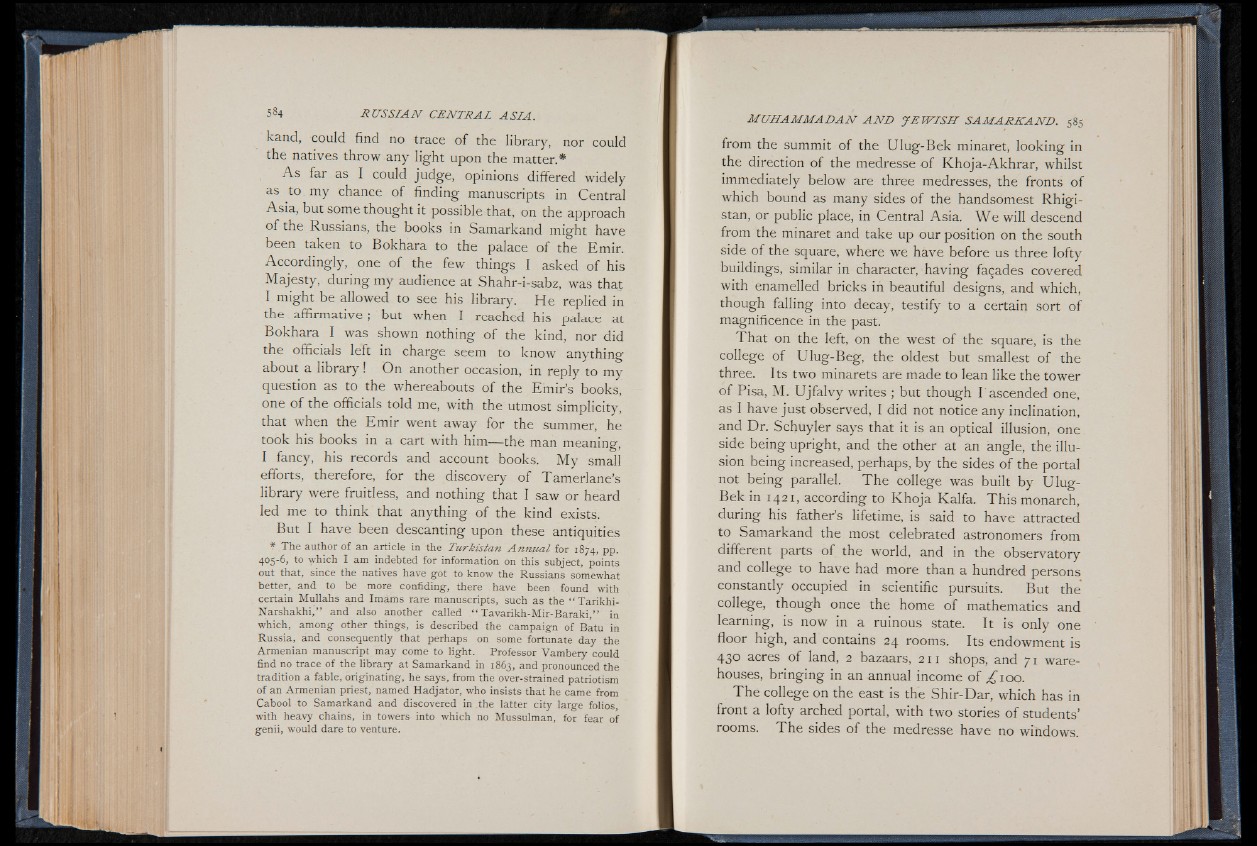
kand, could find no trace of the library, nor could
the natives throw any light upon the matter.*
As far as I could judge, opinions differed widely
as to my chance of finding manuscripts in Central
Asia, but some thought it possible that, on the approach
of the Russians, the books in Samarkand might have
been taken to Bokhara to the palace of the Emir.
Accordingly, one of the few things I asked of his
Majesty, during my audience at Shahr-i-sabz, was that
I might be allowed to see his library. He replied in
the affirmative; but when I reached his palace at
Bokhara I was shown nothing of the kind, nor did
the officials left in charge seem to know anything
about a library! On another occasion, in reply to my
question as to the whereabouts of the Emir’s books,
one of the officials told me, with the utmost simplicity,
that when the Emir went away for the summer, he
took his books in a cart with him— the man meaning,
I fancy, his records and account books. My small
efforts, therefore, for the discovery of Tamerlane’s
library were fruitless, and nothing that I saw or heard
led me to think that anything of the kind exists.
But I have been descanting upon these antiquities
* The author of an article in the Turkistan A n n u a l for 1874, pp.
405-6, to which I am indebted for information on this subject, points
out that, since the natives have got to know the Russians somewhat
better, and to be more confiding, there have been found with
certain Mullahs and Imams rare manuscripts, such as the “ Tarikhi-
Narshakhi,” and also another called “ Tavarikh-Mir-Baraki,” in
which, among other things, is described the campaign of Batu in
Russia, and consequently that perhaps on some fortunate day the
Armenian manuscript may come to light. Professor Vambeiy could
find no trace of the library at Samarkand in 1863, and pronounced the
tradition a fable, originating, he says, from the over-strained patriotism
of an Armenian priest, named Hadjator, who insists that he came from
Cabool to Samarkand and discovered in .the latter city large folios
with heavy chains, in towers into which no Mussulman, for fear of
genii, would dare to venture.
from the summit of the Ulug-Bek minaret, looking in
the direction of the medresse of Khoja-Akhrar, whilst
immediately below are three medresses, the fronts of
which bound as many sides of the handsomest Rhigi-
stan, or public place, in Central Asia. We will descend
from the minaret and take up our position on the south
side of the square, where we hâve before us three lofty
buildings, similar in character, having façades covered
with enamelled bricks in beautiful designs, and which,
though falling into decay, testify to a certain sort of
magnificence in the past.
That on the left, on the west of the square, is the
college of Ulug-Beg, the oldest but smallest of the
three. Its two minarets are made to lean like the tower
of Pisa, M. Ujfalvy writes ; but though I ascended one,
as I have just observed, I did not notice any inclination,
and Dr. Schuyler says that it is an optical illusion, one
side being upright, and the other at an angle, the illusion
being increased, perhaps, by the sides of the portal
not being parallel. The college was built by Ulug-
Bek in 1421, according to Khoja Kalfa. This monarch,
during his father’s lifetime, is said to have attracted
to Samarkand the most celebrated astronomers from
different parts of the world, and in the observatory
and college to have had more than a hundred persons
constantly occupied in scientific pursuits. But the
college, though once the home of mathematics and
learning, is now in a ruinous state. It is only one
floor high, and contains 24 rooms. Its endowment is
430 acres of land, 2 bazaars, 2x1 shops, and 71 warehouses,
bringing in an annual income of .£100.
The college on the east is the Shir-Dar, which has in
front a lofty arched portal, with two stories of students’
rooms. The sides of the medresse have no windows.